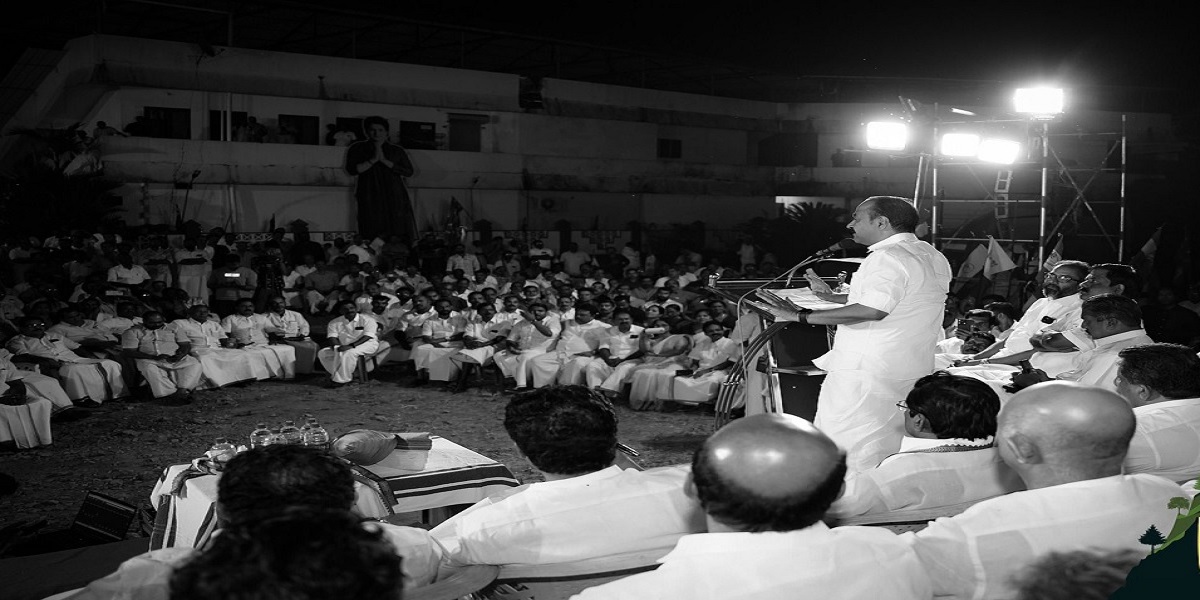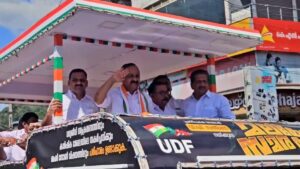The key demands raised during the Malayora Samara Yatra include safeguarding agriculture and farmers in the high ranges, urging the CPI(M)-led state government to formulate policies to mitigate human-wildlife conflicts, and pressing the Union government to intervene in the contentious buffer zone issue that has troubled Kerala’s highland communities for years.
Published Feb 04, 2025 | 5:03 PM ⚊ Updated Feb 04, 2025 | 5:03 PM

In a strategic political move ahead of the local body and 2026 assembly elections, he launched his first-ever political yatra, the Malayora Samara Yatra.
Synopsis: Leader of Opposition in Kerala Assembly VD Satheesan has launched a political campaign, Malayora Samara Yatra. According to the Congress leader, the yatra aims to highlight the CPI(M)-led state government’s inefficiency in handling human-wildlife conflicts. Will the yatra help the Congress in enhancing its vote share in the 2026 Assembly elections?
“This is not Tamil Nadu. This is Andhra Pradesh. People here don’t vote for cinema stars like MGR and Karunanidhi. TDP may win 10-15 seats at most, but Congress will return to power,” was the popular voice in 1982 ahead of the state Assembly elections.
Leading newspapers in India dismissed the frenzy around NT Rama Rao’s Chaitanya Ratham, his modified Chevrolet van, as nothing more than a star’s aura pulling crowds. Every seasoned journalist echoed the same analysis. Every newsroom, and every editorial desk, believed Congress’s monopoly in Andhra Pradesh was unshakable.
Everyone, except one.
Anita Pratap, a young reporter at The Telegraph, refused to accept the consensus. While her peers watched from city newsrooms, she trailed NTR’s rath yatra in an old Ambassador, moving through villages, dusty highways, and forgotten hamlets.
She listened to the crowds, felt their yearning for change, and sensed the tectonic shift others ignored. When her editors urged her to cross-check, “If we are all wrong, it’s fine. But if only we are wrong, it’s bad for business.” However, she stood firm.
She was right.
In a landslide that no other media house predicted, NTR’s TDP stormed to power with a two-thirds majority, crushing Congress’s hold over the state. It was The Telegraph’s first major political scoop, one that reshaped how India viewed political yatras.
Decades later, India continues to witness processions of political faith, from LK Advani’s Ram Rath Yatra to Rahul Gandhi’s Bharat Jodo Yatra.
Now, Congress bigwig and Leader of Opposition in Kerala Assembly VD Satheesan embarks on his first independent political yatra, the Malayora Samara Yatra. Will it be a defining moment for Congress in the state? Can yatras still sway an electorate in an era of digital politics?
As history has shown, the real answer lies not in newsroom predictions, but on the road.

Malayora Samara Yatra when it reached Idukki.
Of late, Kerala has been witnessing increased instances of human-wildlife conflicts, particularly in the “high range” areas, where incidents are reported almost daily.
Given Kerala’s geography, where high ranges account for 48 percent of the land, compared to 42 percent of midland and just 10 percent of coastal area, these conflicts have significant political implications.
Recognising this, Congress leader Satheesan is utilising the opportunity to position himself at the forefront of the debate.
In a strategic political move ahead of the local body and the 2026 Assembly elections, he launched his first-ever political yatra, the Malayora Samara Yatra.
The march began in Erikkoor of the Kannur district on 25 January and will conclude on 5 February in Amboori of Thiruvananthapuram. Spanning the erstwhile states of Malabar and Travancore, it covers 60 of Kerala’s 140 Assembly constituencies. Effectively, the campaign reaches 43 percent of the state’s electorate in its initial phase.
The key demands raised during the Malayora Samara Yatra include safeguarding agriculture and farmers in the high ranges, urging the CPI(M)-led state government to formulate policies to mitigate human-wildlife conflicts, and pressing the Union government to intervene in the contentious buffer zone issue that has troubled Kerala’s highland communities for years.
Despite ongoing factionalism within the Congress, the yatra has witnessed the presence of key leaders, including party’s general secretaries Priyanka Gandhi Vadra and KC Venugopal, state chief K Sudhakaran, Ramesh Chennithala and the leaders of its UDF ally Indian Union Muslim League (IUML).
However, unlike other campaigns, the Malayora Samara Yatra is seen as Satheesan’s independent initiative, with full credit for its conception and execution attributed solely to him.
Political experts see the Malayora Samara Yatra as a test for Satheesan’s ability to lead Congress in the 2026 Kerala Assembly elections. Aravind R Menon, a political researcher from Kochi told South First: ”Satheesan’s effort to address high-range issues is commendable, as these concerns, especially human-wildlife conflicts, require urgent political attention.”
“However, while high-range MLAs back him, not all Congress factions are equally invested. Given that minorities in these regions are a key Congress vote bank, reinforcing solidarity is crucial for the party,” he said.
Satheesan is projecting the Malayora Samara Yatra as more than just an election campaign. He says that even though political, it is primarily a fight for high-range communities.
He emphasised that farmers are struggling with collapsing agriculture, falling crop prices, and escalating wildlife attacks, yet the government remains indifferent.
Satheesan accused the state of neglecting hilly region residents and failing to implement traditional or modern methods to mitigate wildlife threats.
He highlighted Congress’s consistent efforts in the Assembly, moving the highest number of urgent motions on high-range issues, second to coastal concerns.
Citing data, he revealed that since 2018, Kerala has recorded 60,000 wildlife attacks, resulting in over 100 deaths and 8,000 major injuries. In Wayanad alone, nine people have been killed in tiger attacks, while elephant attacks in Aralam claimed 17 lives.
Crops worth crores of rupees have been lost to wildlife destruction. “We cannot abandon these people. We will stand with them and fight for real solutions,” he asserted.
Meanwhile, in Parliament, UDF MPs from Kerala have been actively advocating amendments to wildlife protection laws to align with present-day challenges.
Another important aspect of the yatra is the presence of TMC Kerala Coordinator PV Anvar. Anvar, who recently resigned as an independent MLA representing the Nilambur constituency, has been trying to bring TMC into the UDF fold.
“I am extremely happy to return to my family,” declared Anvar as he joined the Malayora Samara Yatra in Edakkara of Malappuram on 30 January.
Anvar, who had earlier pledged unconditional support to the UDF in the Nilambur by-election, assured the crowd that he had not come empty-handed.
“As and when the UDF returns to power, we will ensure an end to man-animal conflicts in the state,” he promised.
His surprise participation has further fueled speculation about TMC’s potential entry into the Congress-led UDF. Anvar also sent a detailed proposal to Satheesan, Sudhakaran, and Venugopal, advocating for TMC’s formal inclusion in the front.
Political scientist and psephologist G Gopakumar told South First that the recent developments will have little long-term impact, particularly in Anvar’s case.
While the UDF may extend some support to him for now, they are unlikely to welcome his entry into the alliance. UDF can Easily secure the Nilambur constituency, a stronghold of the IUML, even without his backing.
Before the Malayora Samara Yatra, the Congress launched Samaragni, a 20-day statewide yatra from Kasaragod to Thiruvananthapuram, led by Sudhakaran and Satheesan. It aimed to counter the LDF government’s Nava Kerala Sadas and revitalise party workers ahead of the Lok Sabha elections.
The Nava Kerala Sadas, an unprecedented outreach initiative by the LDF, saw the entire Cabinet, including Chief Minister Pinarayi Vijayan, travelling across all 140 Assembly constituencies, holding four public meetings daily. Vijayan used the platform to project his government as a victim of the Union government’s policies.
In January 2024, the BJP launched the Kerala Pada Yatra, led by state President K Surendran, which played a role in securing the party’s first MP in Kerala and boosting its vote share. The BJP also did the Sneha Yatra, targeting the Christian community, which received mixed reactions.
Historically, political yatras in Kerala have had varying impacts. The Jana Raksha Yatra (2016) by the then-KPCC president VM Sudheeran failed to influence the Assembly elections, where the LDF won 91 seats to the UDF’s 47.
In contrast, the Kerala leg of Rahul Gandhi’s Bharat Jodo Yatra (2022) succeeded in mobilisation but did not translate into significant electoral gains nationally.
Aravind noted that while electoral gains from yatras are unpredictable, factors like timing, leadership, grassroots participation, and digital outreach play crucial roles.
However, ground-level engagement often outweighs digital narratives, as seen in Uttar Pradesh, where local media accurately sensed voter sentiment against the BJP despite national media favouring Prime Minister Narendra Modi and Chief Minister Yogi Adityanath.
(Edited by Muhammed Fazil.)
